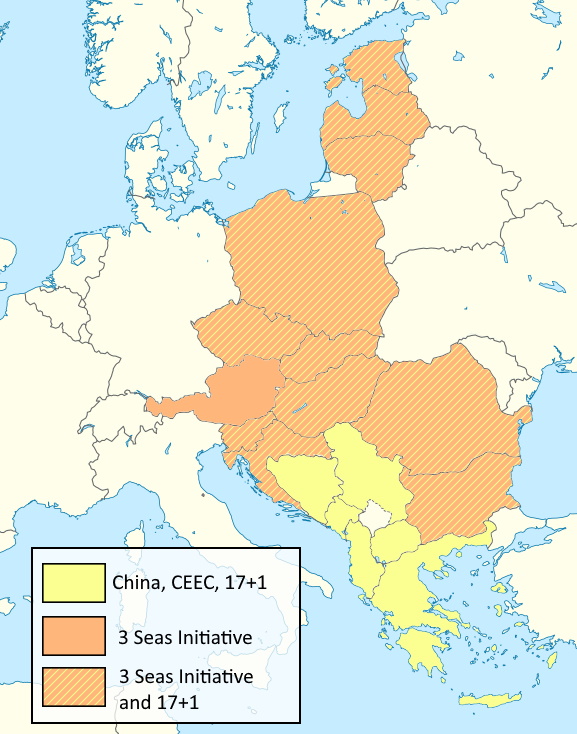
In late October 2020 the Three Seas Summit (virtual) was held in Estonia. This initiative launched jointly by Poland and Croatia in 2015 aims at fostering dialogue and connectivity among Central Europe EU members located between the Adriatic, Baltic and Black Seas.
The Three Seas Initiative may become another vital tool for connecting Europe to the Belt and Road Initiative.
The need for modern infrastructure
Despite EU membership and EU programmes to develop infrastructure (including the TEN-T network), connectivity in Central Europe still requires improvement. Transnational infrastructures are not sufficiently developed. Poland and Croatia have jointly invited every Central European EU member to cooperate regarding energy, transportation and communication.
Although the Three Seas Initiative involves only the states of Central Europe, the initiative should not be seen as a regional project to bypass Western Europe but as an attempt to re-balance connectivity in the European Union.

Multilateral projects
A large number of multilateral projects have been conducted under the Three Seas Initiatives, principally in energy, digitization and transportation.
Among them, the Eastring, an energy project proposed by Slovakia, which consists of the construction of a pipeline connecting Bulgaria to Slovakia. The second phase of the project is due to complete by 2030. This will help Southwest Europe to decrease their dependency on natural gas from Russia and to explore more energy opportunities from Middle-East and the Caspian Sea.
In the digital sector, several projects have been developed to boost connectivity from the Baltic to the Balkans. The digital 3 Seas Initiative developed by the Kosciuszko Institute since 2018 will allow more secure data transfer in the region and will also support innovative industries with the development of transnational fiber-optic networks and 5G infrastructure.
Another project consists in the construction of a test track for autonomous vehicles. The Zalazone in Zalaegerszeg, Hungary, will greatly help innovative companies in Central Europe to develop new mobility solutions.
With the 3 Seas Initiative, the twelve EU members are demonstrating their willingness to build more efficient regional transportation networks. A major project is the Via Carpathia that will connect Klaipeda in Lithuania to Thessaloniki in Greece. This highway network project was first formulated in 2006, and was later included in EU’s Ten-T network, and developed in the framework of the Three Seas Initiative. This new highway network should be completed by 2025. it will help end the geographic isolation of a number of national enclaves along the Eastern borders of the EU.
These projects also support a greater integration with other EU neighbours including countries in Western Balkan, Turkey, Ukraine, Belarus and South Caucasus.
The Three Seas Initiative Fund
To finance these projects, Central European countries have established a fund. The Three Seas Initiative Financial Fund was jointly launched in 2019 by the Polish development bank “Bank Gospodarstwa Krajowego” (BGK) and the Romanian Development bank: EximBank ; with a budget that may eventually reach 5 billion euros. Its first investment financed the acquisition of Cargonunit, a Poland-based locomotive rental company. Investments made by this fund are intended to foster cross-border exchanges in Central Europe.
The Three Seas Initiative and the USA
From the start, the initiative caught the attention of many non European nations. At the first summit in Dubrovnik (Croatia) in 2016, eminent guest speakers from both China and the USA were invited, and US President Donald Trump, himself, attended the event in 2017.
The USA is particularly interested in supporting this Central European initiative and in February 2020, offered to provide up to $1 billion to the Three Seas Initiative fund to promote energy projects in Central Europe. For Washington, the Three Seas Initiative could weaken the relations between the EU and Russia, threaten the German-Russian Nord Stream gas pipeline project and give a boost to US shale gas exports to Central Europe.
However, the Three Seas Initiative is more about regional development than geopolitics, and Central European counties may have their own interests.
The Three Seas Initiative and China’s BRI
Importantly eleven out of the twelve 3 Seas Initiative countries are also members of the 17+1 mechanism that gathers together most of the Eastern and Central European countries and China. The grouping has signed a Memoranda of Understanding with China regarding the Belt and Road Initiative. The two initiatives overlap on many different aspects and synergy may emerge from a stronger cooperation between Central Europe and China.
China is already financing and constructing some infrastructure in Central Europe (a railway project in Hungary, bridge in Croatia…). China’s BRI, EU Ten-T network and The Three Seas Initiative, if coordinated, will be able to bring development and connectivity to the region.
The Three Seas Initiative can also offer more experience to Central European companies to develop multilateral projects, and they may then develop their activities in other regions along the new silk roads.
Both Europe and China suffer from regional inequalities and cooperation on The “Three Seas Initiative” and the “Belt and Road Initiative” may be an adequate framework for sharing experience and expertise.
The Tallinn Summit
At the Tallinn Summit, priority was given to digitisation and Estonian authorities introduced the Smart Connectivity concept. The participants also agreed to increase their financial contribution to the fund.
Share the post "The Three Seas Initiative and the BRI in Europe"
